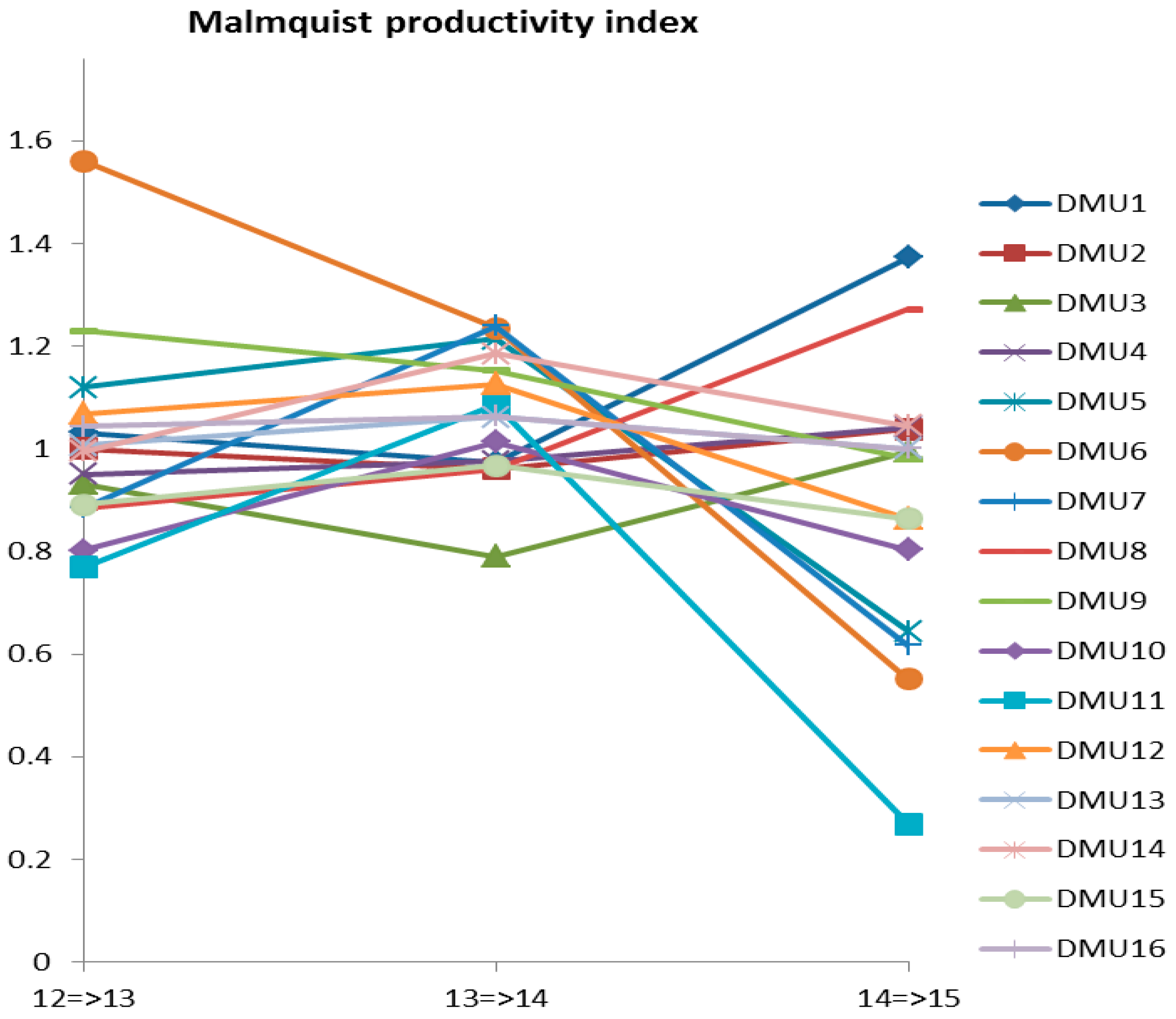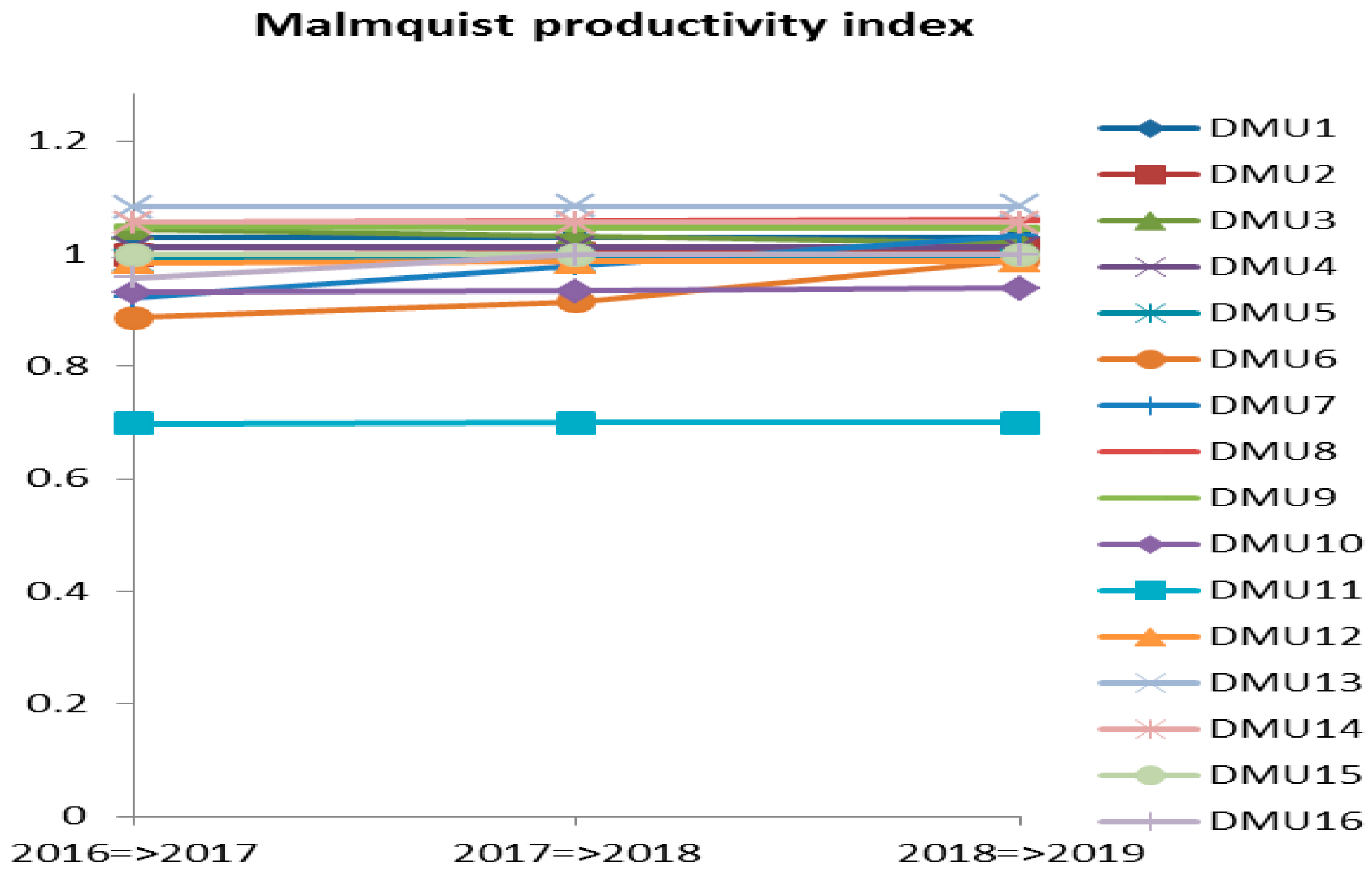4.1. Forecasting Results
This article applies the GM (1,1) model to accurately predict the realistic input/output values of the U.S. logistics industry. The known input/output values in the period 2012–2015 are employed to accurately forecast the input/output values of 2016, 2017, 2018, and 2019. This study selects the total assets of DMU2 (Werner Enterprises, Inc.) as an example (
Table 1) to describe the computation process; likewise, other variables are calculated in the same way. An explanation follows.
From Equation (11) and
Table 1, the primitive sequence
X(0) is obtained as
From Equation (12), one-order AGO sequence of
X(1) is obtained as follows:
In addition, matrix
B and constant vector
YN are accumulated as follows:
We then use the least squares method to find
a and
b:
Use the two coefficients
a and
b to generate the whitening equation of the differential equation:
Find the prediction model from
Substitute different values of
k into the equation:
Use the IAGO method, the author can calculate the
sequence, which is the prediction values given by grey GM (1,1) as below:
According to
Table 2, the total assets of DMU2 (Werner Enterprises, Inc., Omaha, NE, USA) are forecasted to increase from $1613.68 million in 2015 to $1760.70, $1921.79, $2097.61, and, $2289.53 million in 2016, 2017, 2018, and 2019, respectively. Moreover, operational expense costs are forecasted to increase from $1893.07 million in 2015 to $1929.49 million in 2019; total equity, earning per shares, net income, and total revenue are forecasted to increase in the period 2016–2019. Similar calculations exist for the other values, with
Table 3 showing the forecasting results of the GM (1,1) for earnings per share, net income, and total revenue of the 16 GLPs from 2016 to 2019. Moreover, investors all want to know where the economy is headed. Information on output factors is key in partner selection. Forecasting results indicate that there are slight changes of output factors in five of the DMUs in the period 2016–2019, including DMU6 (Werner Enterprises, Inc., Omaha, NE, USA), DMU7 (Con-way Freight, Ann Arbor, MI, USA), DMU11 (CSX Corporation, Jacksonville, FL, USA), DMU12 (Norfolk Southern Corp., Norfolk, VA, USA), and DMU14 (Union Pacific Corporation, Omaha, NE, USA). The decreasing tendency in output factors means that these companies must have a suitable strategy in place to create and sustain a competitive advantage, or start up a new investment in order to meet the increased demand.
In addition, we use the Mean Absolute Percent Error (MAPE) to evaluate the accuracy of the forecasting method. Consider MAPE = (1/
n) Σ (|Actual − Forecast|/Actual) × 100;
n is forecasting number of steps [
60]. The parameters of MAPE show the forecasting ability as follows:
| MAPE < 10%: Excellent |
| 10% < MAPE < 20%: Good |
| 20% < MAPE < 50%: Qualified |
| MAPE > 50%: Unqualified. |
The results of MAPE are shown in
Table 4. The parameter of MAPE is smaller than 10%; this is especially true since the average MAPE of the 16 DMUs is 7%. This confirms that the GM (1,1) model is a highly precise means of prediction.
4.2. Performance Ranking: Super Slacks-Based Model “Super-SBM”
A super SBM model is used to evaluate relative performance, and is used as a ranking measure of the 16 GLPs.
It can be determined from
Table 5 that the super SBM model is highly accurate in the measurement and ranking of efficiency. It has been noted that among the 16 efficient DMUs in this study, DMU13 (Knight Transportation, Phoenix, AZ, USA) achieved optimal efficiency with scores of 1.62, 1.47, 1.31, and 1.42 for 2012, 2013, 2014, and 2015, respectively. According to this, it attained first ranking in 2012, third ranking in 2013, fourth ranking in 2014, and second ranking in 2015. DMU14 (Union Pacific Corporation, Omaha, NE, USA) was ranked in first place in 2015 with a super-efficiency score equal to 1.536. The third and fourth ranks were attained by DMU4 (C.H. Robinson Worldwide, Inc., Eden Prairie, MN, USA) and DMU10 (Hyster-Yale Materials, Cleveland, OH, USA) with efficiency scores of 1.39 and 1.31, respectively. These results indicate that these companies reached their efficiency of output. However, there are some companies with scores under 1, such as DMU7 (Con-way Freight, Ann Arbor, MI, USA), DMU11 (CSX Corporation, Jacksonville, FL, USA), and DMU2 (Werner Enterprises, Inc., Omaha, NE, USA) They were considered to be inefficient from 2012 to 2015. Thus, if they wanted to reach their optimal efficiency level, they should lower their inputs.
From
Table 6, we used the predicted results by implementing GM (1,1) to forecast their future rankings. In the period 2016–2019, DMU14 (Union Pacific Corporation, Omaha, NE, USA) still achieved efficiency and ranked in first place, with efficiency scores of 1.65, 1.78, 1.76, and 1.75, respectively. DMU4 (C.H. Robinson Worldwide, Inc., Eden Prairie, MN, USA) is projected to rank second in 2016, 2017, and 2018, and third in 2019. DMU10 (Hyster-Yale Materials, Cleveland, OH, USA) is supposed to achieve an efficiency score of 1.26 and 1.28, respectively, in 2016 and 2017, and to rank third. In contrast, DMU5 (FedEx Corporation, Memphis, TN, USA) DMU16 (Saia Inc., Johns Creek, GA, USA), DMU12 (Norfolk Southern Corp., Norfolk, VA, USA), and DMU11 (CSX Corporation, Jacksonville, FL, USA) occupy fifteenth and sixteenth place, respectively.
Overall, from the results, we find that most companies have positive values and the rankings within the industry tended to change only slightly on an annual basis. However, only three DMUs presented financial efficiency in the period of 2012–2019, namely DMU14 (Union Pacific Corporation, Omaha, NE, USA), DMU4 (C.H. Robinson Worldwide, Inc., Eden Prairie, MN, USA), and DMU10 (Hyster-Yale Materials, Cleveland, OH, USA). This indicates how well these firms have managed their operations. DMU7 (Con-way Freight, Ann Arbor, MI, USA), DMU11 (CSX Corporation, Jacksonville, FL, USA), DMU2 (Werner Enterprises, Inc., Omaha, NE, USA) and DMU12 (Norfolk Southern Corp., Norfolk, VA, USA) have realized financial inefficiency. They are not performing well in generating revenue compared to the other companies.
4.3. Performance Efficiency Evaluation: Malmquist Productivity Index
It is important to evaluate changes in the total productivity of GLPs in order to understand whether the total productivity of each company is improving or declining over a period of time. This section summarizes the Malmquist Productivity Index (MPI) results obtained from the performance of effectiveness variations from 2012 to 2015. The MPI was used to evaluate the relative change in GLPs’ efficiency. Moreover, the MPI can be decomposed into two components: efficiency and technological changes. These components were separately calculated and then analyzed accordingly.
Table 7 lists the scores of efficiency change, technological change, and productivity change of the 16 GLPs from 2012 to 2015.
Figure 2 shows that the efficiency change index of almost all of the DMUs are outstanding, with efficiency scores greater than 1, except for DMU2 (Werner Enterprises, Inc., Omaha, NE, USA), DMU7 (Con-way Freight, Ann Arbor, MI, USA), and DMU11 (CSX Corporation, Jacksonville, FL, USA), DMU1 (Ryder, Miami, FL, USA) comes in with a score of 1.019 and was the most efficient company on the efficiency change index.
Technical change is often considered in terms of “innovation” or “frontier-shift” effect measures. This can be compared across time by means of the Malmquist index. The improvement achieved mainly stems from the technical change (Frontier) that occurs. The efficiency change can also make a minor contribution to GLPs from 2012 to 2015. Technical change indicates a change in the technology index, which affects the relationship between inputs and outputs. The results show that during the period from 2012 to 2015 there were 13 companies that improved their level of input and achieved technical efficiency scores larger than 1. This indicates that the improvement of these companies is mainly attributable to technical improvement. DMU3 (Hub Group Inc., Downers Grove, IL, USA), DMU10 (Hyster-Yale Materials Handling Inc., Cleveland, OH, USA), and DMU15 (Swift Transportation Co., Phoenix, AZ, USA) are the top U.S. logistics firms. However, the operational performance of these three companies worsened because the scores for their technical and productivity changes dipped below 1, which indicates that they realized productivity loss and lower capital income. Thus, if these companies want to improve their MPIs, they should enhance their technical efficiency in the near future. The worse productivity shown in the period 2012–2015 came from weakened input of technical efficiency in most cases. DMU6 (United Parcel Service, Inc., Atlanta, GA, USA) had the highest productivity growth over the period 2012–2015, with a score of 1.158653147, while DMU11 (CSX Corporation, Jacksonville, FL, USA) showed the greatest loss. The results indicated that 10 of the DMUs, including DMU1 (Ryder, Miami, FL, USA), DMU4 (C.H. Robinson Worldwide, Inc., Eden Prairie, MN, USA), DMU5 (FedEx Corporation, Memphis, TN, USA), DMU6 (United Parcel Service, Inc. Atlanta, GA, USA), DMU8 (J.B. Hunt Transport Services, Inc., Lowell, AR, USA), DMU9 (Old Dominion Freight Line, Thomasville, NC, USA), DMU12 (Norfolk Southern Corp., Norfolk, VA, USA), DMU13 (Knight Transportation, Phoenix, AZ, USA), DMU14 (Union Pacific, Omaha, NE, USA), and DMU16 (Saia Inc., Johns Creek, GA, USA) showed productivity growth; the other six DMUs, namely DMU2 (Werner Enterprises, Omaha, NE, USA), DMU3 (Hub Group Inc., Downers Grove, IL, USA), DMU7 (Con-way Freight, Ann Arbor, MI, USA), DMU10 (Hyster-Yale Materials Handling, Cleveland, OH, USA), DMU11(CSX Corporation, Jacksonville, FL, USA), and DMU16 (Saia Inc., Johns Creek, GA, USA) showed relative productivity loss. The decrease in productivity in this period came from an evolution in the input technical efficiency achieved. Thus, these companies need to learn from more advanced logistics companies and thereby reinforce their organizational values to improve and reach the fittest scale of operating efficiency. Moreover, the main source of improvement will be technical efficiency change.
It is important to understand the differences between the past and the future of DMUs. Obviously, from
Table 8 and
Figure 3 we can see that almost all of the MPIs of companies reached “efficiency” in the period 2016–2019; however, the average of efficiency change is down by 0.57% and the average of technical change increased by 2.15% when compared to the previous year. In the future, the MPI of DMU1 (Ryder, Miami, FL, USA), DMU3 (Hub Group Inc., Downers Grove, IL, USA), DMU4 (C.H. Robinson Worldwide, Eden Prairie, MN, USA), DMU7 (Con-way Freight, Ann Arbor, MI, USA), DMU8 (J.B. Hunt Transport Services, Lowell, AR, USA), DMU9 (Old Dominion Freight Line, Thomasville, NC, USA), DMU13 (Knight Transportation, Phoenix, AZ, USA), and DMU14 (Union Pacific, Omaha, NE, USA) will perform well, all with a score larger than 1. Therefore, these companies are the best choice for purposes of cooperation. In contrast, DMU2 (Werner Enterprises, Omaha, NE, USA), DMU10 (Hyster-Yale Materials Handling, Cleveland, OH, USA), and DMU11 (CSX Corporation, Jacksonville, FL, USA) still maintain inefficient performance during the next four years. Thus, if a DMU wants to reach efficiency, it should follow an enterprise development strategy, prepare financial policies to improve the complete operation effect, and improve in terms of efficiency and technical changes.








